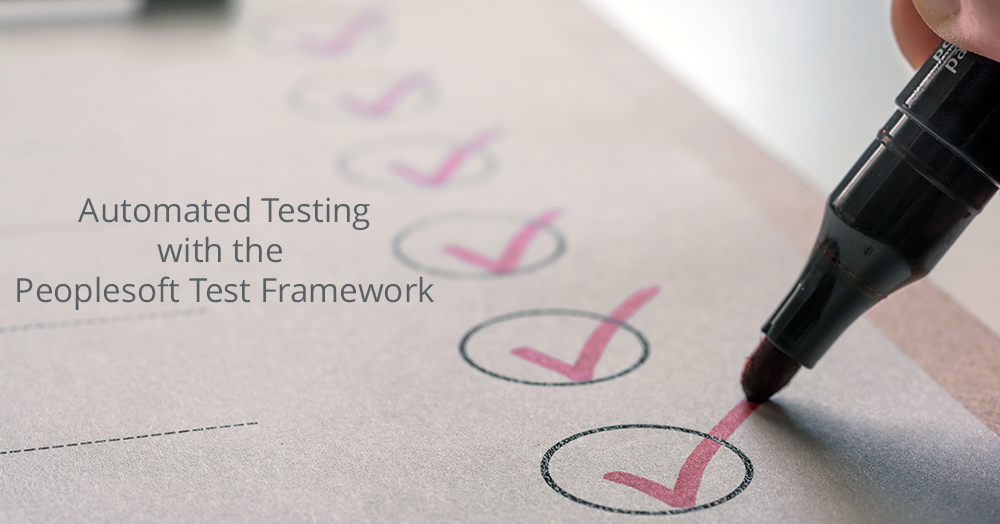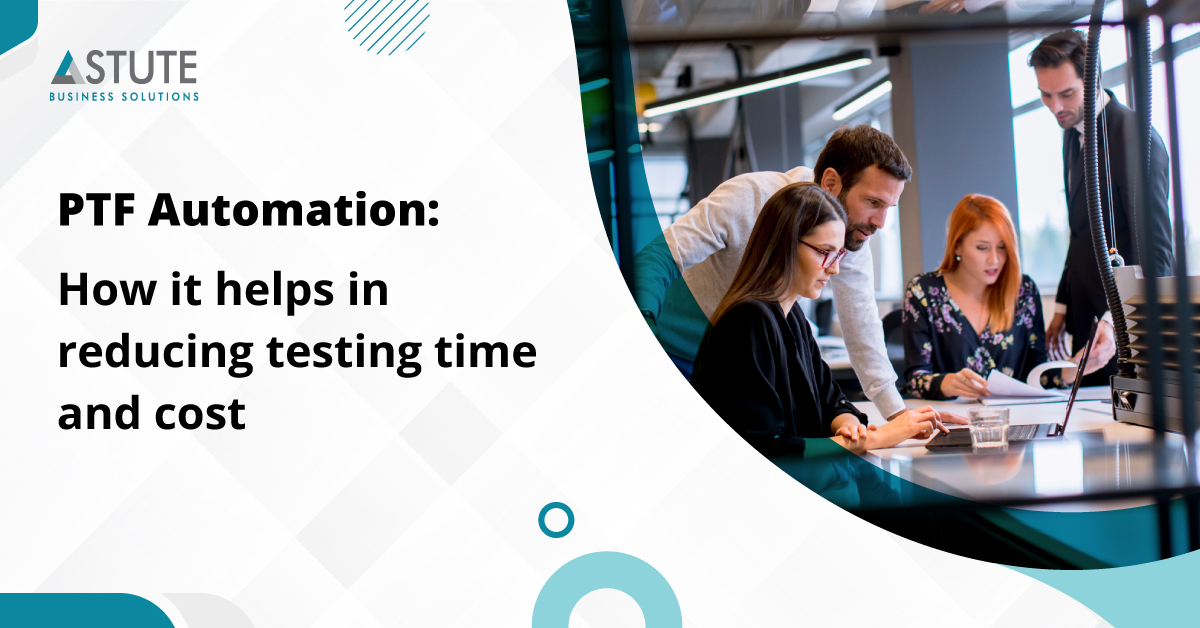
Ensuring PeopleSoft Data Privacy & Security when Testing
Table of Contents
In an increasingly interconnected digital world, the importance of data privacy and security cannot be overstated. For businesses that leverage enterprise applications like PeopleSoft, safeguarding sensitive data becomes even more crucial, particularly during software testing phases. Among the various tools in the PeopleSoft suite, the PeopleSoft Test Framework (PTF) plays an integral role in automating and streamlining testing processes. But just as important as its functionality is its security—how can you ensure that your data remains private and secure while utilizing this framework?
This question calls our attention to the intersection of PeopleSoft Security and the PeopleSoft Test Framework, a critical yet often overlooked area. It is here, in this unique relationship between the two, that the foundation for robust data security in PTF is laid.
In this blog post, we will explore the intricacies of PeopleSoft Security in the context of PTF. We will delve into the risks associated with inadequate data security measures and the crucial role PeopleSoft Security plays in mitigating them. Furthermore, we will provide you with a set of best practices to enhance data privacy and security in your testing environment, along with a real-world case study that brings these practices to life. By the end of this article, you'll have a comprehensive understanding of how to leverage PeopleSoft Security to ensure data privacy and security when working with the PeopleSoft Test Framework.
So, buckle up as we embark on this journey through the landscape of PeopleSoft Test Framework Security!
Understanding PeopleSoft Test Framework and PeopleSoft Security
Before we delve into the specifics of security best practices, it's essential to understand the two primary components at the heart of our discussion: the PeopleSoft Test Framework (PTF) and PeopleSoft Security.
PeopleSoft Test Framework (PTF)
The PeopleSoft Test Framework is a powerful tool developed by Oracle to automate functional testing in the PeopleSoft application suite. By automating repetitive tasks, PTF increases efficiency, reduces errors, and significantly cuts down on the time and resources required for comprehensive testing.
PTF simulates user interactions with PeopleSoft and records real-time user input, such as mouse clicks and data entry, to create test scripts. These scripts can be rerun multiple times, providing a consistent and reproducible testing process. With its capacity to test various scenarios under different configurations, PTF ensures that the applications function correctly under all circumstances, thereby enhancing the overall quality of software delivery.
Want to learn more about PTF?
We have ample resources to equip you with important knowledge regarding implementing PTf testing.
PeopleSoft Security
PeopleSoft Security, on the other hand, is a broad framework that ensures the protection and confidentiality of data within the PeopleSoft suite. It is a comprehensive set of controls and protocols designed to safeguard sensitive information from unauthorized access, disclosure, alteration, or destruction.
PeopleSoft Security operates on several levels, including field-level security, row-level security, and page permissions, among others. It is responsible for managing user roles and permissions, determining who has access to what data, and under what circumstances. It also includes robust features for data encryption, audit logging, and security configuration, which further reinforce data protection.
Understanding the workings of both the PeopleSoft Test Framework and PeopleSoft Security is fundamental to appreciating how they interact. In the following sections, we'll examine this interaction more closely, highlighting its implications for data privacy and security.
The Intersection of PeopleSoft Security and PTF
The unique relationship between PeopleSoft Security and the PeopleSoft Test Framework is central to ensuring robust data privacy and security during testing. Understanding this intersection is key to implementing effective security measures within the PTF environment.
How PeopleSoft Security Integrates with PTF
PeopleSoft Security and PTF are not isolated entities; instead, they work in tandem to provide a secure testing environment. PeopleSoft Security controls play a crucial role in determining how the PTF functions and interacts with the system.
When a test script is run using PTF, it executes under the context of a specific user, adhering to the security settings, roles, and permissions assigned to that user in PeopleSoft. This means the PTF doesn't bypass PeopleSoft security controls; rather, it operates within the defined security framework, ensuring that the test execution respects data privacy and security constraints.
The Significance of this Integration for Data Privacy and Security
The integration of PeopleSoft Security with PTF has significant implications for data privacy and security. It means that the security practices you have established within your PeopleSoft environment also apply to your testing procedures.
For instance, if a user doesn't have permission to view certain sensitive data within PeopleSoft, then a PTF test run under that user's context will also not have access to that sensitive data. This ensures that your sensitive data remains protected, even during testing.
This integration also impacts how you should approach security within your PTF environment. It highlights the need for careful consideration of which user context your tests are running under and underscores the importance of maintaining robust security controls within your overall PeopleSoft environment.
In the next section, we will take a closer look at the potential security risks in a PTF environment and how PeopleSoft Security can help mitigate these risks.
Data Privacy and Security Risks in PTF
While the PeopleSoft Test Framework is an essential tool for ensuring that your applications are running as expected, it is not immune to potential security risks. The very features that make PTF powerful—such as its ability to simulate user interactions and automate repetitive tasks—can also make it a potential target for security breaches if not managed appropriately.
Overview of Potential Security Risks When Using PTF
- Misuse of User Credentials: PTF scripts run under specific user credentials, which, if mishandled, can lead to unauthorized access to sensitive data.
- Improper Handling of Test Data: Without proper protocols, sensitive data used during testing can be exposed, leading to potential data breaches.
- Inadequate User Role Management: If PTF tests are run under user roles with excessive permissions, they could unintentionally expose sensitive data or perform unauthorized transactions.
- Lack of Audit Controls: Without proper audit controls, it can be challenging to track user activities within PTF, making it harder to identify and respond to security incidents.
The Role of PeopleSoft Security in Mitigating These Risks
PeopleSoft Security plays a crucial role in mitigating these potential risks. Here's how:
- Strict User Access Controls: PeopleSoft Security's robust user access controls can prevent misuse of user credentials by ensuring that each user (and hence each PTF test) has access only to the necessary data and functionalities.
- Data Masking and Encryption: PeopleSoft Security allows for data masking and encryption techniques, which can protect sensitive test data.
- Role-Based Access Control: By implementing role-based access control, PeopleSoft Security ensures that PTF tests only have permissions necessary for the testing process, reducing the risk of unauthorized transactions.
- Audit Logging: PeopleSoft Security includes robust audit logging features, which can track user activities in PTF, providing visibility and accountability.
By understanding and effectively mitigating these potential security risks, you can significantly enhance the data privacy and security in your PTF environment. In the next section, we'll share best practices to further strengthen your PeopleSoft Security within PTF.
Best Practices for PeopleSoft Security in PTF
Implementing effective security measures within the PeopleSoft Test Framework relies heavily on adopting best practices. Here are some of the key practices that you should consider:
Utilize Appropriate User Roles and Permissions in PTF
As the PTF operates under specific user credentials, it is crucial to carefully manage these credentials. Create dedicated user accounts for PTF with appropriate roles and permissions, ensuring that they only have access to the necessary data and functionalities. Also, routinely review and update these roles and permissions to align with changing requirements.
Implement Data Masking and Encryption Techniques
Sensitive data used during testing should be handled with utmost caution. Use data masking and encryption techniques provided by PeopleSoft Security to safeguard this data. This includes masking or anonymizing data in test scripts and encrypting data both at rest and in transit.
Regular Audits and Updates of PTF Security Configurations
Regularly audit your PTF security configurations to ensure they're in line with your overall PeopleSoft Security strategy. Look out for any discrepancies or weak points, such as excessive user permissions, and rectify them promptly.
Enforce Strong Password Policies and Secure Communication Channels
Enforce robust password policies for PTF user accounts. This includes using complex passwords, regularly updating them, and never sharing them. Additionally, ensure all communication between PTF and the PeopleSoft server is done over secure, encrypted channels to prevent data interception.
By implementing these best practices, you can enhance the data privacy and security in your PTF environment, effectively leveraging the robustness of PeopleSoft Security. In the next section, we'll look at a real-world case study where these practices were successfully implemented, further emphasizing their importance.
Want to learn more about PTF?
We have ample resources to equip you with important knowledge regarding implementing PTf testing.
Case Study: Successful Integration of PeopleSoft Security in PTF
To bring these concepts to life, let's explore a real-world example of a company that successfully implemented the best practices of PeopleSoft Security within their PTF environment.
Description of the Case Study
Our subject is a large financial institution—let's call it FinCorp—that relies heavily on the PeopleSoft suite to manage various aspects of its operations, from HR to financials. They regularly use the PeopleSoft Test Framework for application testing. However, due to the sensitive nature of their data, maintaining robust data privacy and security during testing was a significant concern.
Implementation of Best Practices
FinCorp's IT team took a proactive approach to secure their PTF environment. They started by creating dedicated user accounts for running PTF scripts, each with narrowly defined roles and permissions to limit data access strictly to what was necessary for testing. They reviewed and updated these roles regularly to ensure they remained appropriate.
Next, they implemented data masking techniques to anonymize sensitive data used in test scripts, ensuring that real, sensitive data was never exposed during testing. They also enforced strong password policies for all PTF user accounts and ensured all communications with the PeopleSoft server were encrypted.
Outcome and Lessons Learned
As a result of these measures, FinCorp was able to significantly enhance the security of their PTF environment. They have not experienced any security incidents related to their use of PTF since these measures were put in place.
The FinCorp case demonstrates how effectively integrating PeopleSoft Security with PTF can help maintain robust data privacy and security during testing. It underscores the importance of implementing best practices, like using appropriate user roles and permissions, masking sensitive data, and regularly auditing security configurations.
In the next section, we'll explore future trends and predictions in the realm of PeopleSoft Security and PTF, and how they might shape the way we approach data privacy and security in the future.
Empower your business with additional resources
Astute provides resources to businesses to enhance their growth for free. Click here to learn more about the provision of Baseline PTF tests.
Future Trends in PeopleSoft Security and PTF
As technology evolves, so do the challenges and opportunities in maintaining data privacy and security. It's crucial to stay informed about emerging trends to continuously improve and adapt our security practices. Here are a few trends and predictions to consider:
Increased Use of AI and Machine Learning
Artificial Intelligence (AI) and Machine Learning (ML) are becoming increasingly prevalent in the realm of cybersecurity. These technologies can help identify and respond to potential security threats more quickly and accurately. In the context of PeopleSoft Security and PTF, we might see AI and ML being used to monitor user activities, detect anomalies, and provide predictive insights to enhance security.
Enhanced Data Masking and Encryption Techniques
As data privacy regulations become more stringent, we can expect to see advancements in data masking and encryption techniques. These enhancements will provide more sophisticated and effective ways of protecting sensitive data during testing, further bolstering the security within PTF.
Greater Focus on Audit Trails and Compliance
With increasing regulatory scrutiny, maintaining comprehensive audit trails and ensuring compliance will become even more critical. This might involve more advanced features for audit logging within PTF and PeopleSoft Security, making it easier to track user activities and demonstrate compliance with various regulations.
Integration with Other Security Tools and Platforms
As enterprises employ a multitude of security tools and platforms, seamless integration between these tools will be essential. We might see PTF and PeopleSoft Security integrating more closely with other security tools, allowing for a more unified and holistic approach to data security.
Keeping an eye on these trends will help you stay ahead of the curve and continue to improve your PeopleSoft Security within the PTF. As we wrap up this discussion, let's revisit the importance of maintaining robust data privacy and security in PTF and the role of PeopleSoft Security in achieving this.
Create a custom-tailored PTF test script
Astute Business Solutions conducts a PTF Project Justification workshop which enables you to create your own PTF test script.
Summary
The journey through the landscape of PeopleSoft Test Framework Security has revealed some crucial insights. We have seen that the relationship between PeopleSoft Security and the PeopleSoft Test Framework is more than just a technical integration—it's the foundation for maintaining robust data privacy and security during testing.
The key to effectively safeguarding your data in a PTF environment lies in understanding this unique relationship and implementing the right security measures. From utilizing appropriate user roles and permissions to implementing data masking and encryption techniques, these best practices ensure that your sensitive data remains protected, even during testing.
The real-world case study of FinCorp underscores the importance of these practices and their effectiveness in enhancing PTF security. Moreover, staying abreast of future trends, like the increased use of AI and Machine Learning in cybersecurity and the advancements in data masking and encryption techniques, will help you continuously improve your security practices.
Finally, the integration of PeopleSoft Security with PTF is not just a necessity—it's an opportunity to reinforce your data privacy and security, to ensure that your testing processes are not just efficient, but also secure. Remember, in the realm of data security, consistent application of best practices and a commitment to continuous learning and improvement can make all the difference.
Enhance Business Outcomes with Astute Business Solutions
We bring optimized tools, expertise gained over the years, and enriched industry knowledge to the table.
Further Reading and Resources
To delve deeper into the intricacies of PeopleSoft Security and the PeopleSoft Test Framework, the following resources can provide further insights and practical guidance:
PeopleSoft Security Configuration Guides
PeopleSoft provides comprehensive security configuration guides that can be a great starting point for understanding and implementing PeopleSoft Security. They cover a wide range of topics, from user role management to data encryption.
PeopleSoft Test Framework User Guides
These guides provide detailed instructions on how to use PTF, including how to record and run test scripts, and how to manage test data.
Online Forums and Communities
Online communities, like the Oracle PeopleSoft Community and other tech forums, are invaluable resources for getting answers to specific questions, learning from others' experiences, and staying updated on the latest trends and best practices.
Cybersecurity Blogs and News Sites
Staying informed about the broader landscape of cybersecurity can help you anticipate and respond to emerging threats. Regularly check reputable cybersecurity blogs and news sites to stay in the loop.
Professional Training and Certifications
Consider professional training or certifications in PeopleSoft Security and PTF. These programs can provide a thorough understanding of these tools and their security implications, and they can also add to your credentials.
By deepening your understanding and continuously learning, you can further enhance the data privacy and security within your PeopleSoft Test Framework environment. Remember, data security is a journey, not a destination. So, keep learning, stay vigilant, and continue to improve your security practices.
Enhance the security of your working infrastructure.
Experts can help you achieve your security goals.
Arvind Rajan is Co-Founder and CEO of Astute Business Solutions. He is leading the expansion of Astute services to include Cloud Managed Services, Disaster Recovery on Cloud, and Integration and Process Automation using Platform Cloud Services.
Search
Tags
Related Posts
Subscribe Our Newsletter
Gain access to exclusive insights, technical know-how and crucial knowledge from Astute experts.
Share Article
See The Team In Action
Upcoming Events
-1.png)
Reach Out
Ready to Connect?
Please fill the following form, we will get back to you within a business day.
Contact Form
Contact Us



